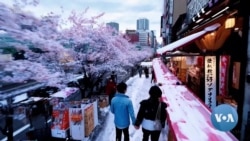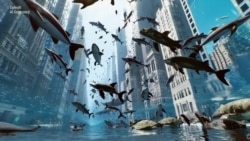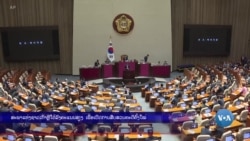ນະວັດຕະກໍາຫລ້າສຸດໃນດ້ານປັນຍາປະດິດ ແມ່ນວິດີໂອຈິດຕະກໍາພາບຖ່າຍເໝືອນຈິງທີ່ສ້າງຂຶ້ນມາຈາກຄໍາເວົ້າພຽງແຕ່ສອງສາມຄໍາເທົ່ານັ້ນ. Deana Mitchell ມີລາຍລະອຽດເລື້ອງນີ້ ໃນລາຍການ LogOn ສຳລັບສັບປະດານີ້ ຊຶ່ງ ບົວສະຫວັນ ຈະນໍາມາສະເໜີທ່ານໃນອັນດັບຕໍ່ໄປ.
ພວກໝານ້ອຍໜ້າຮັກເຫຼົ່ານີ້ ໃນຊີວິດຈິງແລ້ວ ບໍ່ມີເລີຍ, ແມ່ນແຕ່ພວກຄົນຜູ້ຊາຍ ຫຼືພວກນັກບິນອະວະກາດເຫຼົ່ານັ້ນ ກໍບໍ່ມີ.
ພວກເຂົາເຈົ້າລ້ວນແລ້ວແຕ່ຖືກສ້າງຂຶ້ນມາໂດຍໂອເພິນເອໄອ (OpenAI), ຊຶ່ງເປັນບໍລິສັດດຽວກັນທີ່ຢູ່ເບື້ອງຫຼັງຂອງຊອຟແວ ແຊັຕ໌ຈີພີທີ (ChatGPT).
ຜະລິດຕະພັນຫລ້າສຸດນີ້ເອີ້ນວ່າ ໂຊຣາ (Sora). ມັນສາມາດສ້າງວິດີໂອຈິດຕະກໍາເໝືອນຈິງ ທາງດ້ານດິຈິຕອລທີ່ມີຄວາມລະອຽດສູງ, ຈາກການໃຊ້ພຽງແຕ່ການພິມດ້ວຍຂໍ້ຄວາມບອກເທົ່ານັ້ນ.
ມັນກະທັ້ງສະແດງໃຫ້ເຫັນທັດສະນີຍະພາບທີ່ເບິ່ງຄືວ່າ ມັນມາຈາກອະດີດ ຄືແບບນີ້ ໂດຍພຽງແຕ່ພິມຄໍາວ່າ “ພາບວີດີໂອໃນປະຫວັດສາດຂອງລັດຄາລີຟໍເນຍ ໃນລະຫວ່າງຍຸກຄົ້ນພົບ ແລະຂຸດຄົ້ນຄຳ ທີ່ເອີ້ນວ່າ Gold Rush.”
Sora ສາມາດສ້າງວິດີໂອທີ່ມີການອ່ວຍກ້ອງຖ່າຍພາບທີ່ເຄື່ອນໄປມາຕະຫຼອດໄດ້ ໃນແບບສາມມິຕິ, ເຊັ່ນແມວໂຕນີ້ ຫຼື ໝາພວກນີ້, ໂດຍທີ່ມີແສງສະຫວ່າງສາດໃສ່ພວກມັນ ເພື່ອສະທ້ອນໃຫ້ເຫັນຂົນຂອງພວກມັນຢ່າງສົມບູນແບບ; ແມ່ນແຕ່ການພັນລະນາພາບສະທ້ອນໃຫ້ເຫັນຢູ່ໃນປ່ອງຢ້ຽມຂອງລົດໄຟນີ້ ກໍເຮັດໄດ້ຢ່າງຖືກຕ້ອງແມ້ນຢໍາ.
ວິດີໂອທີ່ສ້າງຂຶ້ນໃນການກະຕຸ້ນດ້ວຍຄໍາເວົ້າທີ່ພິມບອກວ່າ, "ວິດີໂອການຖ່າຍພາບເໝືອນຈິງໃຫ້ເຫັນຢ່າງໃກ້ໆ ຂອງກໍາປັ່ນໂຈນສະລັດສອງລໍາທີ່ກຳລັງຕໍ່ສູ້ກັນ ໃນຂະນະທີ່ພວກເຂົາແລ່ນຢູ່ໃນຈອກກາເຟ," ໄດ້ເຮັດໃຫ້ຜູ້ຊ່ຽວຊານດ້ານ AI ບາງຄົນມີອາລົມຕື່ນເຕັ້ນ ໂດຍໃຫ້ຄວາມເຫັນວ່າ ກໍາປັ່ນທັງສອງລໍາຮັກສາພາບເຄື່ອນໄຫວຂອງພວກມັນໃນທຸກມຸມດ້ານໄດ້ແນວໃດ ໃນຂະນະທີ່ກາເຟ ແລະຝອດຍວກຍູ້ໄປມາອ້ອມພວກມັນຢ່າງເໝືອນຈິງແທ້ໆເລີຍ.
ແຕ່ເປັນໜ້າປະທັບໃຈຫຼາຍ ຄືດັ່ງທີ່ໄດ້ປະກົດໃຫ້ເຫັນນັ້ນ, ຜູ້ຊ່ຽວຊານບາງຄົນກໍມີຄໍາຖາມ. ດຣ ໂດມີນິກ ລີສ໌ ຈາກມະຫາວິທະຍາໄລ ຣີດດິງ ຊີ້ໃຫ້ເຫັນວ່າ OpenAI ໄດ້ປະຕິເສດທີ່ຈະແບ່ງປັນຂໍ້ມູນການຝຶກອົບຮົມຂອງຕົນ ແລະທ່ານເຊື່ອວ່າ ມັນເປັນໄປໄດ້ສູງທີ່ຜົນງານຂອງພວກນັກສ້າງຮູບເງົາ, ນັກສ້າງຮູບເງົາກາຕູນ ຫຼື Animator, ຊ່າງຖ່າຍຮູບ ແລະນັກສິລະປິນອື່ນໆຫຼາຍຄົນ ຄົງຈະຖືກນຳໄປໃຊ້ໂດຍບໍ່ມີການຍິນຍອມເຫັນດີຈາກເຂົາເຈົ້າ.
ດຣ. ລີສ໌ ຮອງສາດສະດາຈານດ້ານການສ້າງຮູບເງົາ ຈາກມະຫາວິທະຍາໄລ Reading ກ່າວຜ່ານທາງ Zoom ວ່າ:
"ເຄື່ອງຈັກຮຽນຮູ້ ແມ່ນຄອມພິວເຕີທີ່ສາມາດຮຽນດ້ວຍຕົວເອງ ຕົວຢ່າງເຊັ່ນ ຊາຍຝັ່ງທະເລຂອງລັດຄາລິຟໍເນຍເບິ່ງຄືແນວໃດ. ເມື່ອໃດທີ່ຄອມພິວເຕີເຂົ້າໃຈແລ້ວ ຫຼື ຮູ້ຮູບແບບຂອງຊາຍຝັ່ງ, ຕໍ່ຈາກນັ້ນມັນກໍສາມາດສ້າງຊາຍຝັ່ງທະເລລັດຄາລິຟໍເນຍນັ້ນ ຂຶ້ນມາດ້ວຍຕົວມັນເອງ. ແຕ່ມັນໄດ້ເບິ່ງວີດີໂອທີ່ຖ່າຍໂດຍຜູ້ໃດຜູ້ນຶ່ງ.”
ດຣ. ລີສ໌ ກ່າວວ່າ ໃນປັດຈຸບັນ ບໍ່ມີກົດຫມາຍເພື່ອປົກປ້ອງນັກສິລະປິນ ໃນເລື່ອງນີ້, ແຕ່ວ່າ ເມື່ອເທັກໂນໂລຈີກ້າວຫນ້າໄປ, ກົດຫມາຍກໍຈະຖືກປັບປຸງໃຫ້ກ້າວໜ້າໄປເຊັ່ນກັນ, ອາດຈະເຮັດໃຫ້ບໍລິສັດເຊັ່ນ OpenAI ມີຄວາມສ່ຽງທີ່ຈະຕ້ອງໄດ້ສ້າງຊຸດຂໍ້ມູນໃຫມ່ຂຶ້ນມາ.
ສໍາລັບໃນປັດຈຸບັນນີ້, OpenAI ໄດ້ປ່ອຍໃຫ້ວິດີໂອຈໍານວນນຶ່ງອອກມາ ທີ່ສະແດງໃຫ້ເຫັນຄວາມຜິດພາດທີ່ Sora ໄດ້ເຮັດອອກມາໃນແງ່ຂອງຄວາມເຂົ້າໃຈໃນດ້ານຟີຊິກຢ່າງຖືກຕ້ອງ.
Sora ຍັງບໍ່ໄດ້ເອົາອອກມາໃຫ້ສາທາລະນະຊົນໃຊ້ເທື່ອ ແລະຜູ້ຜະລິດຂອງມັນກໍາລັງເຮັດວຽກກັບນັກຊ່ຽວຊານດ້ານຄວາມປອດໄພ ແລະນັກຄົ້ນຄວ້າເພື່ອປະເມີນຂໍ້ບົກພ່ອງ ແລະຄວາມສ່ຽງທີ່ອາດຈະເກີດຂື້ນ.
ອ່ານລາຍງານເປັນພາສາອັງກິດຂ້າງລຸ່ມນີ້:
The latest innovation in artificial intelligence is photorealistic video created from just a few words. Deana Mitchell has the story in this week’s episode of LogOn.
These cute puppies do not actually exist. Nor does this gentleman. Or these astronauts.
They have all been created by OpenAI, the same company behind ChatGPT.
This latest product is called Sora. It can digitally generate high-resolution, photorealistic video, just from text prompts.
Even showing scenes that look like they are from the past like this, just by typing “historical footage of California during the Gold Rush.”
Sora can generate videos with dynamic camera motion through three-dimensional space, like this cat or these dogs, with the light perfectly reflected on their fur; even accurately depicting a reflection in the window of this train.
A video created with the prompt, “photorealistic closeup video of two pirate ships battling each other as they sail inside a cup of coffee,” has some AI experts swooning, commenting how the two ships maintain their animation on all sides, while the coffee and foam move realistically around them.
But as impressive as it seems, some experts have questions. Dr. Dominic Lees of the University of Reading points out that OpenAI has refused to share its training data and he believes it is likely that the work of many filmmakers, animators, photographers and other artists was used without their consent.
Dr. Dominic Lees, University of Reading, Associate Professor of Filmmaking:
“Machine learning is a computer that’s teaching itself what, for instance, the California coastline looks like. Once it’s got an understanding or pattern of it, then it can generate its own California coastline. But it’s looked at videos made by someone.”
Lees said there are no current laws protecting artists from this, but that as technology progresses, so will the laws, possibly putting companies like OpenAI at risk of having to create new datasets.
For now, OpenAI has released several videos showing mistakes that Sora has made in regard to properly understanding physics.
Sora is not yet released to the public and its makers are currently working with security experts and researchers to assess its flaws and potential risks.












ຟໍຣັມສະແດງຄວາມຄິດເຫັນ